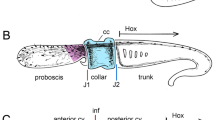Summary
A comparison of central neurons controlling circumanal gill movements in 5 species of dorid nudibranch molluscs with those known to control movements of the dorsal gill tufts in the dendronotid nudibranchTritonia, suggests that the neurons controlling these two gill types are homologous. Four symmetrical pairs of neurons, 2 in the pleural ganglia and 1 each in the cerebral and pedal ganglia, were found to control the circumanal gills in the dorids; three of these pair (pedal and pleural) correspond to similar neurons inTritonia. InTriopha carpenteri, a dorid nudibranch having dorsal tufts as well as circumanal gills, the same neurons control both types of gill. The common neural control of dorsal tufts and circumanal gills revealed here, coupled with the widely observed conservatism in neural evolution, supports the hypothesis that these two gill types have a common evolutionary origin.
Similar content being viewed by others
References
Blackshaw, S.E.: Dye injection and electrophysiological mapping of giant neurons in the brain ofArchidoris. Proc. R. Soc. Lond. (Biol.)192, 393–419 (1976)
Blackshaw, S.E., Dorsett, D.A.: Behavioural correlates of activity in the giant cerebral neuronsof Archidoris. Proc. R. Soc. Lond. (Biol)192, 421–437 (1976)
Chase, R., Goodman, H.E.: Homologous neurosecretory cell groups in the land snailAchatina fulica and the sea slugAplysia californica. Cell Tiss. Res.176, 109–120 (1977)
Dorsett, D.A.: Neuronal homologies and the control of branchial tuft movements in two species ofTritonia. J. Exp. Biol.61, 639–654 (1974)
Dorsett, D.A., Willows, A.O.D.: Interactions between neurons mediating tuft withdrawal inTritonia hombergi. J. Exp. Biol.61, 655–666 (1974)
Franc, A.: Sous-classe des opisthobranches. In: Traité de zoologie: anatomie, systématique, biologie. Tome V, Fascicule III. Grassé, P.P. (ed.) pp. 608–893. Paris: Masson 1968
Gainer, H.: Electrophysiological behavior of an endogenously active neurosecretory cell. Brain Res.39, 403–418 (1972)
Gillette, R., Davis, W.J.: The role of the metacerebral giant neuron in the feeding behavior ofPleurobranchaea. J. Comp. Physiol.116, 129–159 (1977)
Kater, S.B., Kaneko, C.R.S.: An endogenously bursting neuron in the gastropod mollusc,Helisoma trivolvis. J. Comp. Physiol.79, 1–14 (1972)
Mittenthal, J.E., Wine, J.J.: Segmental homology and variation in flexor motoneurons of the crayfish abdomen. J. Comp. Neurol.117, 311–334 (1978)
Morton, J.E.: The form and functioning of the palliai organs in the opisthobranchAkera bullata, with a discussion on the nature of the gill in Notaspidea and other tectibranchs. Veliger14, 337–349 (1972)
Morton, J.E.. Yonge, C.M.: Classification and structure of the Mollusca. In: Physiology of Mollusca, Vol. I. Wilbur, K.M., Yonge, G.M. (eds.), pp. 1–58. New York, London: Academic Press 1964
Parmentier, J.: Mapping studies of a gastropod brain. Brain Res.59, 201–210 (1973)
Potts, G.W.: The respiratory anatomy and physiology of two dorid opisthobranchs with information of their ecology. PhD. Thesis, Queen Mary College, University of London (1966)
Senseman, D., Gelperin, A.: Comparative aspects of the morphology and physiology of a single identifiable neuron inHelix aspersa, Limax maximus andAriolimax californica. Malacologic. Rev.7, 51–52 (1974)
Smith, T.G., Barker, J.L., Gainer, H.: Requirements for bursting pacemaker potential activity in molluscan neurons. Nature253, 450–452 (1975)
Thompson, S.H., Smith, S.J.: Depolarizing afterpotentials and burst production in molluscan pacemaker neurons. J. Neurophysiol.39, 153–161 (1976)
Thompson, T.E.: Studies on the ontogeny ofTritonia hombergi Cuvier (Gastropoda, Opisthobranchiata). Philos. Trans. R. Soc. Lond. (Biol.)245, 171–218 (1962)
Thompson, T.E.: Biology of Opisthobranch Molluscs. Vol. I. London: Ray Society 1976
Thompson, T.E., Slinn, D.J.: On the biology of the opisthobranchPleurobranchus membranaceus. J. Mar. Biol. Assoc. U.K.38, 507–524 (1959)
Weinrich, D., McCaman, M.W., McCaman, R.E., Vaughn, J.E.: Chemical, enzymatic and ultrastructural characterization of 5-hydroxytryptamine-containing neurons from the ganglia ofAplysia California andTritonia diomedia. J. Neurochem.20. 969–976 (1973)
Weiss, K.R., Kupfermann, I.: Homology of the giant serotonergic neurons (metacerebral cells) inAplysia and pulmonate molluscs. Brain Res.117, 33–49 (1976)
Willows, A.O.D., Dorsett, D.A., Hoyle, G.: The neuronal basis of behavior inTritonia. I. Functional organization of the central nervous system. J. Neurobiol.4, 207–237 (1973)
Author information
Authors and Affiliations
Additional information
I am grateful to Dr. A.O.D. Willows for advice throughout the study and for useful comments on the manuscript. I also thank Drs. A. Kohn, T. Audesirk and G. Audesirk for critical reading of the manuscript. Thanks also to the directors and staffs of the Portobello Marine Laboratory. Laboratoire Arago, Plymouth Laboratory and Friday Harbor Laboratories. This work was supported by National Science Foundation Research Grant BMS75 13597 to A.O.D. Willows and National Institutes of Health Training Grant PHS GMO7108, and indirectly by a Guggenheim Fellowship to A.O.D. Willows.
Rights and permissions
About this article
Cite this article
Dickinson, P.S. Homologous neurons control movements of diverse gill types in nudibranch molluscs. J. Comp. Physiol. 131, 277–283 (1979). https://doi.org/10.1007/BF00610435
Accepted:
Issue Date:
DOI: https://doi.org/10.1007/BF00610435




